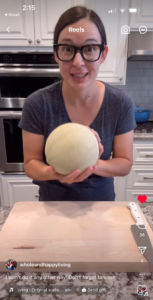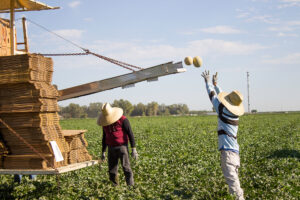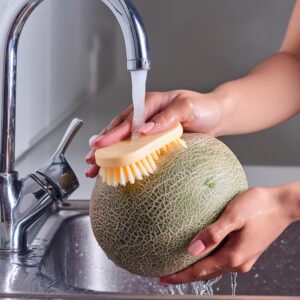 Cantaloupe: To Wash or Not to Wash?
Cantaloupe: To Wash or Not to Wash?
People will debate anything on social media. But when it comes to washing cantaloupe before eating, there should be no debate. JUST WASH IT!
 A couple weeks ago, we caught wind of a conversation on Instagram sparked by a video from @wholeandhappyliving who was demonstrating how to cut and peel a cantaloupe. She started the demo by “washing” the cantaloupe with a damp washcloth. We watched with interest as comments began to stream in on the merits of washing cantaloupe before slicing. Admittedly, we were a bit shocked at some of what people had to say:
A couple weeks ago, we caught wind of a conversation on Instagram sparked by a video from @wholeandhappyliving who was demonstrating how to cut and peel a cantaloupe. She started the demo by “washing” the cantaloupe with a damp washcloth. We watched with interest as comments began to stream in on the merits of washing cantaloupe before slicing. Admittedly, we were a bit shocked at some of what people had to say:
“I don’t eat the outside. I’m not washing it!”
“I have never washed my melons in 50+ years.”
“I don’t wash my melons. They come pre-washed.”
After reading comments like these, we decided it was time for another quick primer on the smart practice of washing cantaloupe before eating and why it’s important.
You may be aware that cantaloupe has been the source of foodborne illness outbreaks in recent years. While getting sick from any kind of fresh produce is statistically extremely rare, it does happen. And cantaloupe can be particularly tricky because of the rough texture of the rind which can be an inviting place for bacteria to grow.
For this reason, the California Cantaloupe Advisory Board and experts in food safety highly recommend that you wash cantaloupe before eating. In fact, we recommend using a vegetable brush, not just a towel, to scrub the entire surface, much like you would for a baked potato. Using a scrub brush allows you to thoroughly clean the nooks and crannies of a cantaloupe rind in a way that a washcloth cannot.
A few people on the above-mentioned Instagram feed correctly noted that, although you don’t eat the outside of a cantaloupe, it is possible for bacteria hiding on the rind to be passed to the edible flesh when you cut through the melon with your knife. And that is exactly the reason experts recommend a thorough scrubbing before you slice into a cantaloupe.
It’s also a good practice to clean your knife and any cutting surfaces you’re using. This should be done any time you’re cutting fruits or vegetables. And, even more important, is to not share any of the cutting surfaces or utensils used for preparing fresh produce with raw chicken or any other meat. In truth, improper sanitation practices in your own kitchen are the most common cause of foodborne illnesses.
But what about pre-washed produce? We can’t say for certain that the user above who said they only buy pre-washed cantaloupe is mistaken. But we can tell you that most cantaloupe is NOT pre-washed.
 In California, most of the cantaloupe is picked and packed right in the field without any kind of water coming into contact with the melons. This is actually a safety measure in itself, because the introduction of water into any fresh produce packing operation presents added risk. Dry, hot environments like the cantaloupe growing areas of California are actually thought to be the safest places in the world to grow cantaloupe because it is inhospitable to the growth of pathogens.
In California, most of the cantaloupe is picked and packed right in the field without any kind of water coming into contact with the melons. This is actually a safety measure in itself, because the introduction of water into any fresh produce packing operation presents added risk. Dry, hot environments like the cantaloupe growing areas of California are actually thought to be the safest places in the world to grow cantaloupe because it is inhospitable to the growth of pathogens.
Some cantaloupes are packed in facilities that incorporate washing. But rest assured, these operations are subject to very stringent sanitization requirements to make sure melons are handled safely. However, this type of washing is not meant to render the cantaloupes “ready-to-eat.”
It’s always a good idea to wash any whole cantaloupes you buy in a store from a bulk display. Think about it – that cantaloupe has been touched (and probably sniffed) by a number of people before it gets to your kitchen. Once again – just wash it.
Now, if you’re buying pre-cut, packaged cantaloupe – that’s a whole different story. In this case it likely does not need to be washed. But read the label. As with other fresh produce items or leafy greens, directions on the package will let you know if the product is OK to eat straight out of the container. Look for words like “ready to eat” or “tripled washed” to indicate whether or not you need to re-wash.
And while it may seem very obvious to many of you, California cantaloupe farmers have created some how-to video demonstrations on how to wash and cut cantaloupe – just in case. We’re here to help and all we want is for everyone to enjoy sweet, juicy California cantaloupe safely.
So, get out your scrubbing brush, knife and a spoon – then go ahead and dig into the sweet stuff!

 Cantaloupe: To Wash or Not to Wash?
Cantaloupe: To Wash or Not to Wash?





